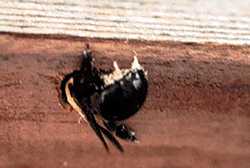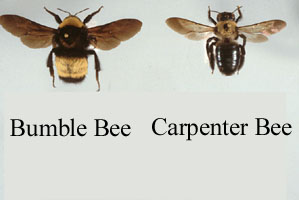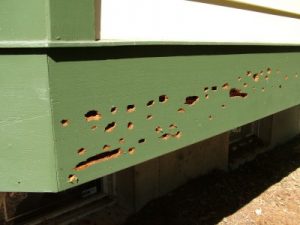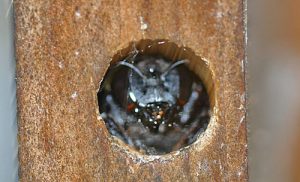 It’s that time of year where bees begin to buzz and phones begin to ring. Carpenter bees are waking up and looking to do what they’ve been doing for thousands of years.
It’s that time of year where bees begin to buzz and phones begin to ring. Carpenter bees are waking up and looking to do what they’ve been doing for thousands of years.
The Carpenter bee is a solitary bee that is basically harmless to you and I. Try telling that to the upset homeowner who is being dive bombed by 15 or 20 of them around her back deck. Although they are not part of a colony they are all attracted to the same exposed wood so it’s not uncommon to find several dozen of them competing for their stake in eave or section of your wood siding. The heavy bee also produces a menacing buzz when she flies which usually sends the Mrs. into a panic.
The male Carpenter bee has no stinger but the female does, she’s not known to bite or sting unless caught in clothing, your hair or your hand trying to swat them. This big bee is simply drilling out a hole where she can lay her eggs and deposit food for the next generation.
The hole drilled is ‘perfect’ by any carpenters standard. Sometimes called the drilling bee she prefers drilling vertically from under the wood but will go right into the side as well. The hole almost always goes with the grain and may extend about 11 inches. I’ve seen some boards so riddled with Carpenter bee caverns that they literally fall apart with the touch.
 The Carpenter bee resembles the Bumble bee which is aggressive and will sting with less provocation. Both bees have yellow and black markings but the carpenter bees abdomen is shiny black and appears hairless. The Bumble bee is noticeably hairy all over.
The Carpenter bee resembles the Bumble bee which is aggressive and will sting with less provocation. Both bees have yellow and black markings but the carpenter bees abdomen is shiny black and appears hairless. The Bumble bee is noticeably hairy all over.
The Carpenter bee over winters in abandoned holes only to come out in the spring to complete the life cycle. Using balls of pollen to feed the larva they are considered beneficial. Well if you don’t count the 11 inch hole in your deck awning.
 Although painted or sealed woods are less desirable they can chew right through it and since they don’t eat the wood, Cedar which is naturally a pest deterrent has no effect. To control the bees you can treat the exposed timber with borate such as Timbor. The bee still will begin to drill but die soon after. Most times control methods come after the bee is through the surface and into the heart of the board where your borate won’t reach. At this time it will be necessary to use an aerosol or dust and treat the cavity. This can be done with an injector tip. Be careful however because she may be inside working and come out hopping mad if you don’t get in a good shot.
Although painted or sealed woods are less desirable they can chew right through it and since they don’t eat the wood, Cedar which is naturally a pest deterrent has no effect. To control the bees you can treat the exposed timber with borate such as Timbor. The bee still will begin to drill but die soon after. Most times control methods come after the bee is through the surface and into the heart of the board where your borate won’t reach. At this time it will be necessary to use an aerosol or dust and treat the cavity. This can be done with an injector tip. Be careful however because she may be inside working and come out hopping mad if you don’t get in a good shot.
For the bees undoubtedly buzzing around you at this time you should do nothing. I say this because they are very unlikely to sting unless aggravated and being that they are very skilled fliers you won’t get in a clean whack and they will begin to defend their ‘stake.’ Just keep your mind on the hole you’re treating and move away when done. Later you should come back and seal the hole with putty or wooden plug.
For next year’s invasion and they will come, treat the wood with the borates and you shouldn’t have to endure this nerve racking process.
have to endure this nerve racking process.
If for any reason you feel this is too much, just call in a pro, they know what to do and can at least provide some relief and then come back later to set you up for next year’s drilling party.




